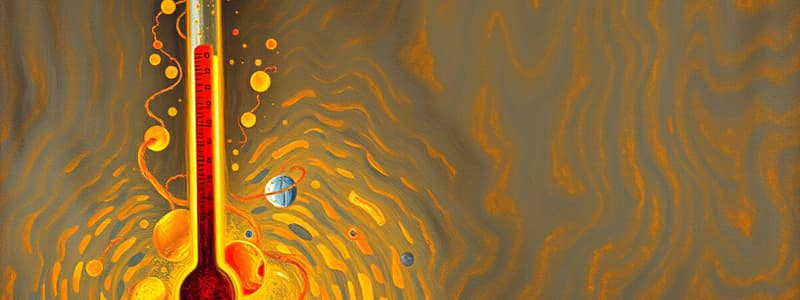Podcast
Questions and Answers
What does temperature measure in a substance?
What does temperature measure in a substance?
- Mass of the substance
- Total energy of all particles
- Potential energy of particles
- Average kinetic energy of particles (correct)
A hot object will have a lower average kinetic energy than a cold object.
A hot object will have a lower average kinetic energy than a cold object.
False (B)
What happens to thermal energy when a hot object is placed in contact with a cold object?
What happens to thermal energy when a hot object is placed in contact with a cold object?
Thermal energy flows from the hot object to the cold object until both reach the same temperature.
The total amount of energy, including both kinetic and potential energy, in a substance is known as its __________.
The total amount of energy, including both kinetic and potential energy, in a substance is known as its __________.
Match the following terms with their definitions:
Match the following terms with their definitions:
What happens to the fast molecule when it collides with the slow molecule in the scenario involving hot and cold bricks?
What happens to the fast molecule when it collides with the slow molecule in the scenario involving hot and cold bricks?
Thermal energy flows from the cooler object to the warmer object.
Thermal energy flows from the cooler object to the warmer object.
What is the condition for a system to be in thermal equilibrium?
What is the condition for a system to be in thermal equilibrium?
In the zeroth law of thermodynamics, objects in contact with one another are in thermal equilibrium if they have the same __________.
In the zeroth law of thermodynamics, objects in contact with one another are in thermal equilibrium if they have the same __________.
Match the term with its description:
Match the term with its description:
Flashcards are hidden until you start studying
Study Notes
Temperature, Energy, and Heat
- Temperature is defined as being proportional to the average kinetic energy of particles in a substance.
- Pain felt from touching a hot object stems from the faster-moving particles in the hot object compared to those in a cold object.
- Internal energy (thermal energy) encompasses both the kinetic energy of particles and their potential energy (separation and orientation).
- Heating adds thermal energy to a system, while cooling removes it.
Energy Flow and Thermal Equilibrium
- A temperature difference results in thermal energy flowing from warmer to cooler objects until they reach thermal equilibrium.
- In thermal equilibrium, energy transfer ceases as temperatures equalize, despite ongoing microscopic energy exchanges.
- The zeroth law of thermodynamics states that objects in contact with each other are in thermal equilibrium if they share the same temperature.
Heat Transfer
- Heat, measured in joules, is defined as the energy transferred between objects due to a temperature difference.
- An object's thermal energy increases when it absorbs heat, and decreases when it releases heat.
- Heat is not "contained" in objects; rather, they possess thermal energy, which they can exchange.
Temperature Scales
-
Celsius scale:
- Water freezes at 0 °C and boils at 100 °C.
- The lowest temperature in this scale is -273.15 °C (absolute zero).
-
Fahrenheit scale:
- Developed by Gabriel Fahrenheit, where water freezes at 32 °F and boils at 212 °F.
- Body temperature is defined as 98.6 °F.
- The degree interval in Fahrenheit is approximately half that of the Celsius scale, needing 180 degrees to span the freezing to boiling point of water compared to 100 degrees in Celsius.
Studying That Suits You
Use AI to generate personalized quizzes and flashcards to suit your learning preferences.




